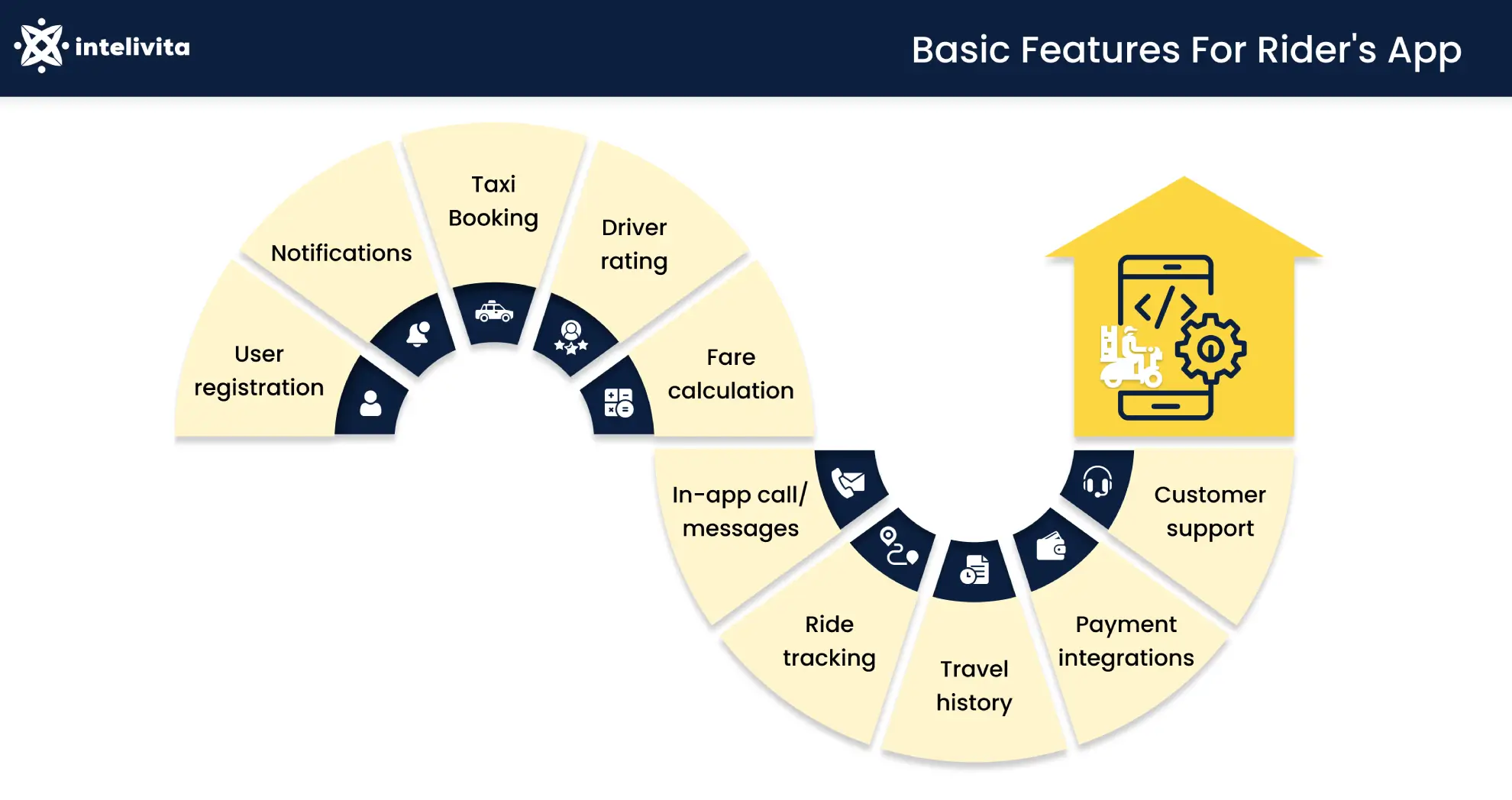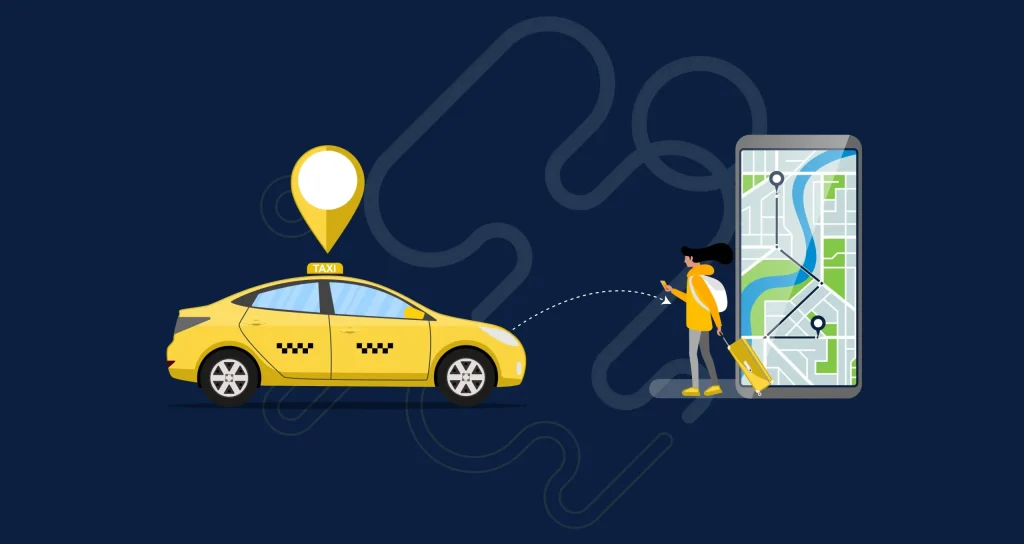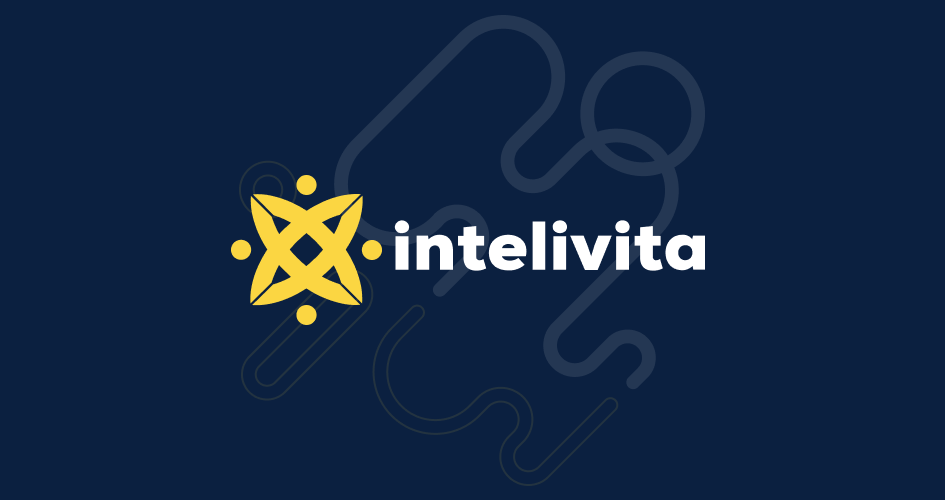Have you heard of the word Uberization?
The Cambridge Dictionary defines it as the act or process of changing the market for a service by introducing a different way of buying or using it, especially using mobile technology.
At the origin of the word is the popular taxi booking app Uber.
Founded in 2009, Uber introduced a new business model in the taxi market that destabilized the traditional model of taxis.
With its global recognition, Uber has become a role model for many.
How to build an app like Uber is a topic that sparks curiosity in the minds of those who want to develop a taxi booking app.
Are you brimming with taxi app ideas? Then, read this article to know how to bring your ideas to life!
Uber did a simple but significant thing. They noticed a pain point in the taxi hiring process, i.e., they realized that people found it time-consuming and often frustrating to get taxis.
To address this, they developed a solution that took the taxi-booking process online, making it faster and easier.
People embraced the idea so much that Uber has over 93 million users on a monthly basis today. In 2020, Uber generated $57.9 billion in global gross bookings.
Today, 70% of the US ride sharing market belongs to Uber and it is the largest company in the sector.
Along with it, Lyft is another popular taxi booking app that holds 30% of the market.
If you are looking to build an app like Uber or Lyft, this article will give you complete guidance on how to get started.
Make sure you read it till the end!
So, let’s begin with the basics.
How Does Uber App Work
The goal of the Uber app is simple – simplify the taxi traveling experience for people.
This goal is reflected In every step of the taxi booking process.
From automatically detecting passenger pickup location to providing live ride status and automating payments, it makes the user’s experience effortless.
6 critical steps in the workflow of taxi booking apps like Uber are:
Step 1: Ride request
The passenger makes a ride request through the app. They enter their pickup and destination locations and choose the type of taxi.
The app shows the ride fare upfront so that passengers can choose the suitable one.
Step 2: Ride confirmation
Once a ride request is made, the passenger verifies all the details and confirms the ride.
Step 3: Matching process
Uber searches for nearby drivers to match the ride. A request is sent to the driver.
The driver may accept or reject the request. If the driver accepts, the ride is initiated. Otherwise, the request is transferred to the next available driver.
Step 4: The ride
After a driver accepts a ride request, the passenger is notified about it.
The driver details, their location, and the real-time location of the driver are provided to passengers so that they can track the taxi and be aware of the estimated arrival time.
Step 5: Payment
Once a ride is over, payment is automatically completed.
The fee is dedicated from the payment account passenger has previously added to the app.
Uber provides multiple payment options like credit cards, debit cards, PayPal, etc.
Step 6: Rating
After each ride, a rating is requested from passengers. The ratings help the other Uber users choose a better trip.
It is a key part of Uber’s business logic and greatly enhances its service reliability.
How to Make an App like Uber or Lyft
To make a successful taxi booking app, it is imperative to have a well-defined execution plan.
From concept creation to implementation, a clear step-by-step process needs to be defined for achieving the best output.
Does it sound overwhelming? It need not be!
To help you get started, we will share the key steps to follow to build an app like Uber or Lyft.
These are the foundational steps and according to your unique needs, you can add more steps.
Step #1: Requirement Analysis
The first step is to analyze your requirements. For this, you will need to conduct extensive market research.
Addressing questions like what is your mission, what unique proposition will your platform deliver, what the current market looks like, and what the users need comes here.
Once the requirement analysis is done, you will have a clear idea about your target audience and the business model.
Step #2: Documentation
The output of step 1, from the requirements to the business model, app features, and app platforms are documented in this step.
Documentation helps to create a blueprint and a reference point to come back to, any time you get stuck during the app development process. Defining the scope, timeline, milestones, etc. at this stage is very useful.
Step #3: App Development
This is the step where you see your ideas taking life. With the documentation created, you can now start working on the app development.
You may choose to create your own in-house app development team or hire a taxi app development company to build the app for you. In step 3, the app is created, tested, and made ready for launch.
Step #4: App Deployment
With performance tests and functionality checks completed, your app is ready for deployment.
Publish it to the corresponding app store and it’s ready to be used by the target audience.
It’s always a good idea to go live with a minimum viable product (MVP) as it helps you understand your user requirements better and create a successful app.
Step #5: Marketing
Many people think app development is over by step 4. But, that’s not the case.
You need to drive people to engage with your app. A well-defined marketing strategy is required for this.
Did you know Uber hosted and sponsored tech events to attract riders and drivers when they were starting off?
They even gave trial rides to people! You need to create such unique marketing ideas for your business too to gain attraction.
Features Required for an App like Uber or Lyft
To understand the features required for an app like Uber or Lyft, you need to first have clarity on the different parties involved in the app’s working.
This would help you identify the different components of the model. Essentially, the Uber-like model has:
- Passengers who use the service to book rides
- Drivers who partner with the company to offer their service
- Admins who manage and monitor the overall work.
So, to make a taxi booking app, you would need to create three interfaces – a passenger app, a driver app and an admin panel.
Features for Passenger App
The features of passenger apps can be categorized into two even, basic and advanced. The basic features include:
User registration: Sign-up option for passengers to register and create a profile.
This could be done using their phone number, email id, or via social media profiles.
Also, a sign-in option is needed for registered passengers.
Taxi booking: Provision for passengers to enter their address, provide their pickup location, choose the type of taxi, book a ride and so on.
Fare calculation: Upfront calculation and display of fare depending on the distance to be traveled, the taxi type, traffic conditions, etc.
Ride tracking: Ability to track the ride and driver location in real-time after a taxi booking is confirmed.
Payment integrations: Implementation of in-app payment options.
Multiple payment methods like credit/debit cards, PayPal, net banking, etc. should be integrated.
Notifications: Push notifications to keep passengers updated about booking status, ride status, driver details, etc.
Driver rating: Option to review and rate the driver to enhance the overall customer experience.
In-app call/messages: Provision to communicate with the driver through calls or messages from the app itself.
Travel history: Records of passengers’ previous bookings, rides, and payments.
Customer support: Provision to connect with customer support to resolve any issues passengers may face while using the app.
Aside from the basic features, implementing the following advanced features will help you deliver better value to passengers.
Ride cancellation: Option for passengers to cancel rides with deduction of convenience fee depending on the time of cancellation.
The closer to pickup time a ride is canceled, the more fee is deducted.
Split payment: Feature that allows passengers to split the cost of the ride with fellow riders when traveling in a group.
Scheduled rides: Option to book taxis in advance for a later time by setting the required pickup time.
Interactive map: Feature to display all the taxis on a map in real-time to enhance the booking experience.
Voice input: Implementation of voice recognition to accept voice commands and increase accessibility.
Book for others: Provision to book taxis for others from one’s passenger account.
Waiting list: Option to add their booking request to the waiting list during rush hours when all taxis are occupied.
Preferred driver: Option to choose your preferred driver while booking the ride.
Features for Driver App
Similar to features of passenger apps, we can categorize features of driver apps into basic and advanced.
The basic features to include are:
Driver profile: Feature for driver profile creation with personal information like name, age, and vehicle information like license, insurance and other documents.
The details on the driver profile should be verified by the admin.
Ride alert: Option to receive new ride alerts containing passenger location, route, etc.
The driver should be able to respond to new ride requests with “accept” or “decline”.
Notifications: Push notifications for ride alerts, booking information, route change, ride completion, reviews, etc.
In-app call/messages: Feature to communicate directly with passengers from the app through calls or messages.
Navigation: Navigation guidance for drivers to get the best route for trips, know real-time traffic overview, get alternate route information, etc.
Reports: Revenue reports for drivers to look up their earnings and get their trip details on a daily/weekly/monthly basis.
Advanced features for driver apps are:
Heat maps: A feature for drivers to compare passenger density of different locations and plan their schedule in locations with high passenger density.
Next ride: Option to get notified of the next ride and accept it while completing the current ride.
Passenger destination: Provision for doctors to select rides for specific passenger destinations only.
Waiting time: Option to charge an additional amount to the base fare in scenarios where drivers have to wait for a long time.
Quest earnings: Option for drivers to complete quests (predefined number of rides) and earn more upon its completion.
Features of Admin Panel
An admin panel is the central control point used by admins to manage and monitor passengers, drivers, payments, trips, locations, ratings, and so on.
The admin panel will be a web-based platform and should contain the following essential features.
- Passenger and driver management
- Booking management
- Fare management
- Vehicle management
- Notifications management
- Rating management
- Navigation management
- Passenger and driver support
- Driver payroll management
- Promotions and discounts management
- Analytics integration
- System content management
Revenue Model of Taxi Booking App like Uber
The end goal of every app development is to make money from the app.
Therefore, determining the revenue model beforehand is imperative to achieve a consistent revenue stream.
Uber’s revenue model is one of the most successful models in the taxi market today.
They do not own a car fleet; they act as a mediator platform for drivers and passengers to connect.
A main stream of Uber’s profit is from the rides.
Their ride calculator combines the following factors to derive a price for each ride.
- Base fee: A flat fee Uber charges for their service. It is based on car type and ride location.
- Cost per mile
- Cost per minute
- Booking fee: A minimal fee to cover their operational cost.
Uber’s pricing model is dynamic and the fare can be influenced by current traffic conditions, driver availability, holiday season, etc.
Other than this, Uber charges a cancellation fee from passengers if they cancel their booked ride after a certain period of time.
Along with being an additional source of revenue, this also helps Uber track the number of cancellations they receive.
Advertisements and brand partnerships are also major revenue sources for Uber.
Uber promotes other businesses on their platform and helps them reach a broader audience. In return, they charge a commission for the promotions.
Technology Behind Uber-like Apps
The key technological integrations needed to build taxi booking apps like Uber are geolocation, push notification, and payment integration.
To build an app like Uber on iOS and Android platforms, the technological integrations required would be:
| iOS | Android | |
|---|---|---|
| Navigation & Geolocation | MapKit, Corelocation | Google Maps Android API, Google Locations Services API |
| Push Notifications & Management | Apple Push Notifications Service (APN), Twilio, Nexto, Plivo, Sinch | Firebase Cloud Messaging (FCM), Twilio, Nexto, Plivo, Sinch |
| Payment Gateway Integration | Stripe, PayPal, BrainTree, Apple Pay | Stripe, PayPal, BrainTree, Google Pay |
Apart from the integrations, other technologies and programming languages are also to be considered to create a taxi booking app.
The programming languages used are Swift for iOS development and Kotlin for Android development.
For the backend, languages such as Python, Java, PHP, Ruby on Rails, or Node.js are used.
How Much Does it Cost to Develop an App like Uber?
When it comes to the cost of taxi app development, it is difficult to give a one-size-fits-all answer.
This is because the cost can fluctuate depending on different factors. Some key factors that influence cost are:
Business type: For startups, the cost to make a taxi booking app is significantly lower compared to large-scale taxi business apps.
Startups can launch an MVP at a minimal budget. That’s not the case with large-scale businesses as they would need to create an app that aligns with their internal business operations.
Features: The number of features and their complexity is a determining factor in the cost.
The more the number of features, the higher will be the cost.
Similarly, for complex features, the cost of app development would increase as the effort would be more.
Platform choice: The choice of platform, ie, iOS or Android plays a big role in the cost.
Whether the app needs to be launched on one platform or both platforms will decide the budget that would be needed for the development.
To arrive at this decision, business owners can look at the market research and see which platform their target audience is prominently using.
Technology: Technology is interrelated to the platform choice.
Native app development and hybrid app development are the two options here.
Both have their own advantages and disadvantages, so it’s up to the business owner to decide which one to go for.
Geography: If you are outsourcing your development to a taxi app development company, geography influences the cost very much.
Countries like North America and the UK have high hourly rates for developers ($100 – $200) while Eastern Europe and India ($20-&80) offer cheaper hourly rates.
As an estimate, we can say that the cost of developing an MVP of a Uber-like application will come around:
- For driver apps – $15,000 for one platform and $30,000 for two platforms
- For passenger apps – $30,000 for one platform and $60,000 for two platforms
- For admin panel – $15,000
Intelivita’s Experience in Creating Taxi Booking App like Uber
With nearly a decade of experience in the app development industry, Intelivita is a team you can trust to deliver reliable app solutions for your every need.
Taxi app development is our strong niche and we have a team of developers who are the best in developing state-of-the-art taxi booking apps.
We work with a diverse tech stack so you can be ensured that whatever your requirement is, we have the knowledge and resources to carry it out.
We have been recognized by top industry leaders like Clutch, AppFutura, and GoodFirms for our outstanding contributions in the app development field and excellent customer service.
By delivering high-quality and intuitive apps for clients all over the world, we have established ourselves as a trusted taxi app development company.
To hire dedicated mobile app developers for your taxi solution, reach us right away!







